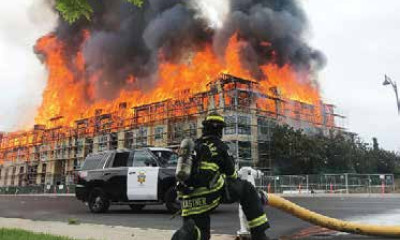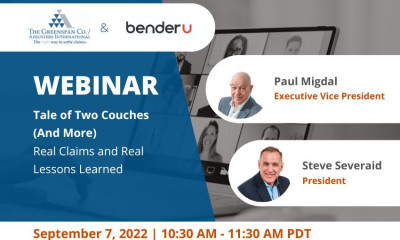A Private Adjuster's Perspective: Examination Under Oath
Examination Under Oath
An Arrow in the Quiver
Simply put, an examination under oath (EUO) is a very thorough and comprehensive inquiry with questions posed to and sworn answers elicited from an insured. It is a formal proceeding that can be required by an insurer during their review of an insured’s property insurance claim. It is governed by the specific terms of the policy of insurance, which is a contract between the insurer and the insured.
The EUO requirement and its process are also supported by state statute.
It is conducted by the insurer’s representative (usually its counsel) in the presence of a court reporter. For over 100 years, the insurer’s right to conduct an examination under oath has been upheld and broadly defended.
While similar to a deposition, there are several important distinctions between the two proceedings:
- Court rules of civil procedure governing depositions do not apply. Depositions may, by local or federal rules, have time limits; examinations under oath do not.
- While insureds may be represented by counsel at either proceeding, at an examination under oath, counsel is not generally permitted to participate by either asking questions or lodging objections/ complaints.
- Absent good cause, a litigant deponent in a civil matter is seldom required to give more than one deposition. To the contrary, most property insurance policies provide that an insured shall submit to an EUO as often as reasonably required.
- Testifying falsely at an EUO, may lead to a denial of a claim and the voiding of a policy; false testimony at a deposition may lead to a criminal charge of perjury.
There are several reasons why an examination under oath might be requested. The most benign reason is to allow the insurer to obtain all that it needs to know about the facts and circumstances of a claimed loss to determine its rights and obligations under its policy of insurance. Another positive reason is to investigate the possibility of subrogation against a third party, responsible for the damage.
There are also unpropitious reasons, such as the origin and /or the size of a loss, the claim is suspicious or questionable; there are indications of misrepresentations or fraud, either before or after the loss; there are issues of insurable interest or lack thereof; the possibility of an increase in hazard or a breach of warranty; and many more.
Most states have statutes governing policy forms and substance, including the right of an insurer to insist that an insured submit to an examination under oath. As an example of such legislation, California Insurance Code Section 2071 provides, in relevant part, as follows:
The insured, as often as may be reasonably required and subject to the provisions of Section 2071.1, shall…submit to examinations under oath by any person named by this company, and subscribe the same…
Duties in the Event if Loss or Damage
An example of a policy provision incorporating this statutory mandate follows:
We may examine any insured under oath, while not in the presence of any other insured and at such times as may be reasonably required, about any matter relating to this insurance or the claim, including an insured’s books and records. In the event of an examination, an insured’s answers must be signed. (ISO Form CP 00 10 10 12 pages 10-11 of 16).
An insured’s rights when confronted with an insurer’s demand for an examination under oath are detailed in Section 2071.1 and include, inter alia, the following:
- The right to be represented by counsel.
- The right to have the examination conducted upon reasonable notice, at a reasonably convenient place and for a reasonable length of time.
- The right to receive, free of charge, a copy of the proceeding transcript and an audio or video recording, if one exists.
The right to take an examination under oath is both statutory and contractual. Section 2071 designates the insured as the potential examinee and the policy will, most likely, offer a definition of the insured (e.g., spouse, child under a certain age, etc.). However, one must carefully examine policy language in order to determine who else might be summoned for the proceeding.
Note that some insurers, in setting forth their rights and the insured’s duties, have imposed upon the insured the additional obligation (to the extent it is within their power to do so) to present employees, representatives, household members, public adjusters, and others for an examination. When the insured is an entity and not a person, the representative chosen to respond should be the one most knowledgeable.
The insurer has great latitude in conducting the examination, and questioning may be quite far-reaching and extensive. The sole limitations to this broad power are that the questioning must be relevant, material, and reasonably necessary to allow the examiner to investigate and process the claim.
What is the consequence of failing to appear for an examination under oath or, if appearing, failing to answer material and relevant questions or, if answering, doing so falsely? Simply stated: the insured may have given the insurer grounds for voiding the policy or refusing to make payment.
Important side notes: reliance upon advice of counsel or invocation of the Fifth Amendment are not reasonable excuses for failing to comply with the examination under oath requirement.
For further information on this topic, read “Everything You Always Wanted to Know About Examinations Under Oath-But were Afraid to Ask!” (Adjusting Today).
Examination Under Oath
Featured Case Study
One of the more unfavorable reasons an insurer might demand an examination under oath is the hope or expectation that the insured will make material misrepresentations during their sworn testimony. As noted in the accompanying article, material misrepresentations made to an insurer, either before or after a loss, often give rise to a rightful denial of claim.
Insurers commonly rely upon misrepresentations such as overstating costs/values or misstating the age/condition of lost items as justification for their claim denials. Another area of insurer inquiry, in their quest for claim denial, is financial wherewithal of the insured: how and where did the insured obtain the funds to purchase their belongings?
These misrepresentations go to the very heart of the matter of claims recovery and are therefore often deemed material: how much the insurer must pay the policyholder for replacement costs and actual cash value in performance of its contractual obligations.
The Claims of Mr. and Mrs. Jones:
In 2020, Mr. and Mrs. Jones suffered a major fire at their residence. The Joneses had purchased their home in 2010 and had extensively remodeled it, spending several hundred thousand dollars between 2012 and 2014. They outfitted their home with high-end furnishings and other expensive personal property purchased during this time.
As required by their policy of insurance, the Joneses had to file a claim with supporting documentation (e.g., building estimate, contents inventory) for their losses. This support material required a detailed accounting of the Jones’s remodel costs and contents acquisition: dates and costs of acquisition, age and condition of items, and current replacement cost and estimated actual cash value (depreciated values).
The Joneses were unaware of the very human and very natural tendency of what cognitive psychologists have named the telescoping effect. The telescoping effect or bias refers to how people perceive the timing of an event. It is natural for us to perceive recent events as being more remote and distant events as being more recent than they really are. The former is known as backward telescoping while the latter is called forward telescoping. The telescoping effect, in addition to affecting our recall of timing, may also cause us to mistake the amounts of expenditures made, or monies received in given periods.
How did all of this apply to Mr. and Mrs. Jones and their claims? Under the influence of the telescoping effect, the Jones’s initial itemization of their loss overstated the amount of their remodeling and personal property expenditures and showed them to be more recent than they really were. Fortunately, the Joneses had engaged the services of the Greenspan Co./Adjusters International to assist them in preparing and negotiating their claims. Based upon experience, when they received the Joneses’ initial schedules, the Greenspan team concluded that the insurer would likely demand an examination under oath, suspecting the perpetration of claims fraud.
Keeping in mind the natural tendency of people to telescope, members of the Greenspan team--including estimating, adjusting, and inventory personnel--spent hours with the Joneses, refining the claims for accuracy. As a result, much more accurate estimates and inventories were submitted, and the Joneses’ insurer had no reason to suspect fraud or misrepresentation. Examination under oath was completely avoided.





